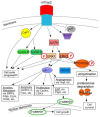Trop2 and its overexpression in cancers: regulation and clinical/therapeutic implications
- PMID: 26000093
- PMCID: PMC4426947
- DOI: 10.18632/genesandcancer.40
Trop2 and its overexpression in cancers: regulation and clinical/therapeutic implications
Abstract
Trop2 is a transmembrane glycoprotein encoded by the Tacstd2 gene. It is an intracellular calcium signal transducer that is differentially expressed in many cancers. It signals cells for self-renewal, proliferation, invasion, and survival. It has stem cell-like qualities. Trop2 is expressed in many normal tissues, though in contrast, it is overexpressed in many cancers and the overexpression of Trop2 is of prognostic significance. Several ligands have been proposed that interact with Trop2. Trop2 signals the cells via different pathways and it is transcriptionally regulated by a complex network of several transcription factors. Trop2 expression in cancer cells has been correlated with drug resistance. Several strategies target Trop2 on cancer cells that include antibodies, antibody fusion proteins, chemical inhibitors, nanoparticles, etc. The in vitro studies and pre-clinical studies, using these various therapeutic treatments, have resulted in significant inhibition of tumor cell growth both in vitro and in vivo in mice. A clinical study is underway using IMMU-132 (hrS7 linked to SN38) in patients with epithelial cancers. This review describes briefly the various characteristics of cancer cells overexpressing Trop2 and the potential application of Trop2 as both a prognostic biomarker and as a therapeutic target to reverse resistance.
Conflict of interest statement
The authors declare that they have no competing interests.
Figures



References
-
- McDougall ARA, Hooper SB, Zahra VA, Sozo F, Lo CY, Cole TJ, Doran T, Wallace MJ. The oncogene Trop2 regulates fetal lung cell proliferation. American Journal of Physiology; Lung Cell Molecular Physiology. 2011;301:L478–L489. - PubMed
-
- Bignotti E, Zanotti L, Calza S, Falchetti M, Lonardi S, Ravaggi A, Romani C, Todeschini P, Bandiera E, Tassi R, Facchetti F, Sartori E, Pecorelli S, et al. Trop-2 protein overexpression is an independent marker for predicting disease recurrence in endometrioid endometrial carcinoma. BMC Clinical Pathology. 2012;12:22. - PMC - PubMed
-
- Ciccarelli FD, Acciarito A, Alberti S. Large and diverse numbers of human diseases with HIKE mutations. Human Molecular Genetics. 2000;9:1001–1007. - PubMed
-
- Cubas R, Li M, Chen C, Yao Q. Trop2. a possible therapeutic target for late stage epithelial carcinomas. Biochim Biophys Acta. 2009;1796:309–314. - PubMed
Publication types
LinkOut - more resources
Full Text Sources
Other Literature Sources
Research Materials
Miscellaneous

